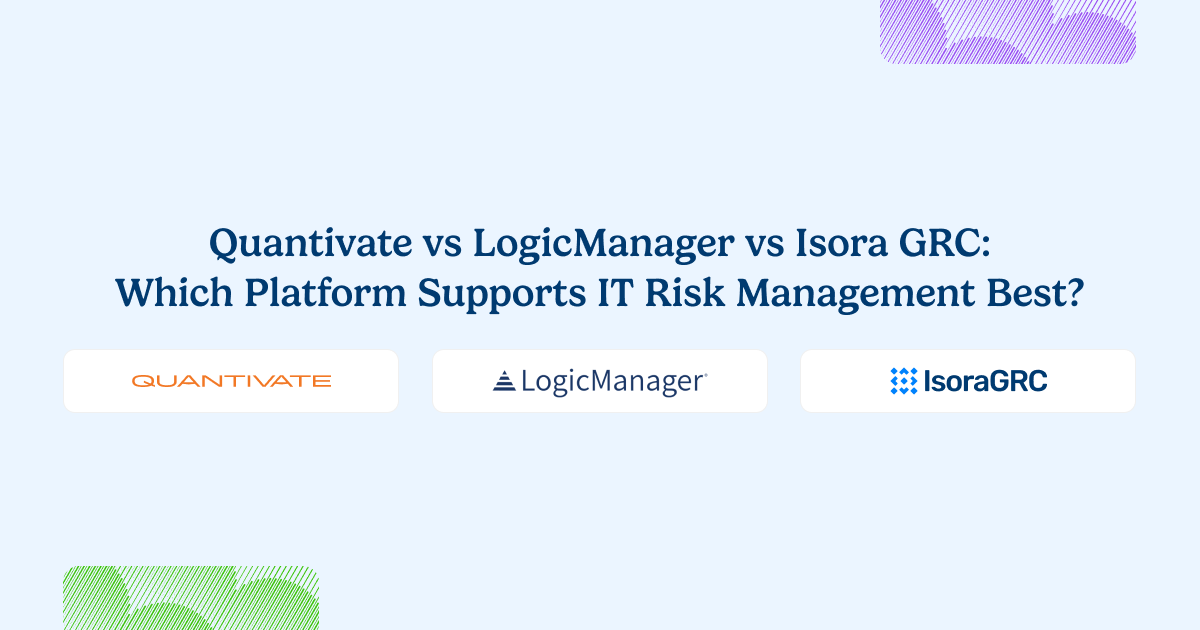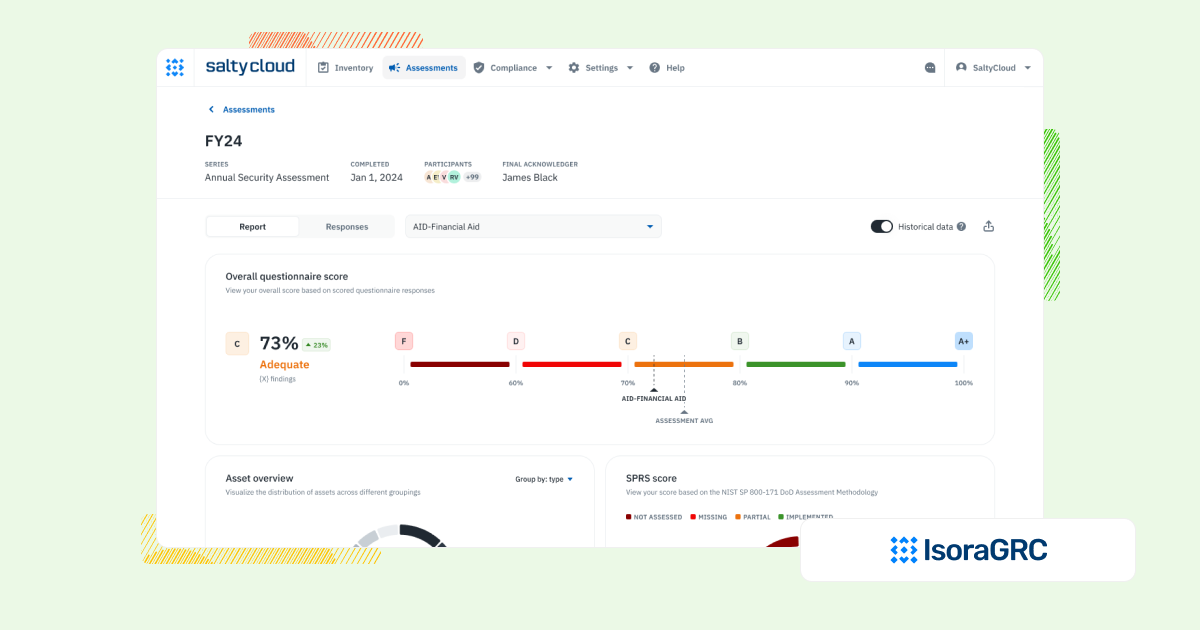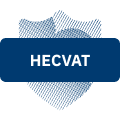
Every security team needs a simple, scalable way to manage IT risk—without getting trapped in complicated processes.
Platforms like Quantivate and LogicManager offer broad GRC functionality, designed to cover compliance, audits, and risk management.
But when a platform tries to do everything, security teams are often left with too much complexity and not enough clarity. These systems can be hard to adopt, slow to configure, and too disconnected from the real workflows of managing IT risk across assets and vendors.
Isora GRC takes a different approach. It’s purpose-built for security teams who need to assess inventories, track risks, and manage vendors—without the burden of traditional GRC complexity.
Let’s take a more thorough look.
Choosing the Right Platform for IT Risk Management
Quantivate and LogicManager provide wide GRC functionality, but they’re designed primarily for governance and compliance leaders—not security teams on the ground. This often results in complicated setups, rigid workflows, and a lack of flexibility when teams need to move quickly.
Isora GRC focuses on the real day-to-day needs of security and risk teams. It offers structured workflows for internal and external assessments, vendor and asset inventory management, exception handling, and risk register tracking—without the need for heavy configuration or complex modules.
The Workflow That Matters: Managing IT Risks and Compliance
Managing IT risk is a continuous, people-driven process. It involves sending assessments to internal teams and vendors, collecting responses, managing inventories, identifying risks, and tracking remediation activities—all while ensuring visibility across the organization.
Broad GRC platforms often slow this work down with disconnected modules, administrative overhead, and workflows that feel disconnected from how security teams operate.
Isora GRC brings these critical risk management workflows into a single, intuitive platform—giving teams the structure they need without slowing them down, and helping them stay aligned as risks evolve.
How Each Platform Supports IT Risk Management Workflows
| Workflow Area | Quantivate | LogicManager | Isora GRC |
| Assessment Management | Basic tools exist but feel limited. Custom setups don’t work well. Most workflows stay manual, which slows things down. | Pre-built templates help with assessments. Still, report tools feel complex. Extra training may be needed to use them well. | Centralized, intuitive assessment dashboard across business units, vendors, and assets. Built specifically for security teams. |
| Questionnaire Delivery & Completion | The system handles surveys, but not smoothly. The layout feels clunky. Making custom surveys is tough. | Survey tools work within the full system. But handling and sorting files stays tricky, which can slow teams down. | Customizable and prebuilt questionnaires for frameworks like NIST, ISO, GLBA, HIPAA, and more. Designed for internal and external collaboration. |
| Inventory Tracking | Asset tracking tools don’t cover large or complex setups. Connecting with other tools feels limited and weak. | The platform shows risks, assets, and controls in one view. Still, some tools feel hard to use. Users may need help or training. | Centralized tracking of assets, vendors, and organizational units with integration support for existing data sources. |
| Risk Register & Exception Management | The register works but lacks deep customization. Exceptions need manual effort. Complex needs may not fit well here. | You can customize the risk register. But some parts, like child risks, feel limited. That can hurt how well exceptions get managed. | Flexible, collaborative risk register with scoring, status, evidence, and ownership tied directly to assessments. Exception management is built-in and intuitive—no extra modules or configuration required. |
| Scoring, Reporting & Risk Visualization | Reports look plain. Customizing them feels hard. For strong visuals, teams may need outside tools. | Dashboards and reports look good and work well. Still, some users want stronger options to match different reporting needs. | Automated scorecards, risk maps, and executive-friendly reports with actionable insights—no manual config required. |
| Collaboration & User Experience | The layout feels hard to use. Sharing data across teams isn’t smooth. Most users need training to get full value. | The layout feels clean and easy to use. Auto-save helps. New users may need time to set things up and learn how to use the tools. | WCAG-compliant, award-nominated interface with built-in commenting, team workflows, and fast onboarding. |
| Implementation & Setup | Setup takes time. Onboarding feels tricky for complex teams. Without training, progress stays slow. | Setup usually goes fast. Support teams respond quickly. Still, users want better training and clearer guides to unlock full features. | No-code setup in days or weeks. Minimal IT lift required. Designed to go live quickly across teams and vendors. |
What Sets Isora GRC Apart?

Isora GRC was purpose-built for information security teams—designed to support the real workflows behind risk and compliance, not just generate reports. While legacy GRC platforms require months of configuration and rigid processes, Isora takes a modern, scalable approach:
- Purpose-built for security and third-party risk teams
- No extra modules or cross-department bloat—just the workflows that matter.
- Easy for anyone to use
- Clean UI, no complex training, and built to drive adoption across the org.
- Streamlined for action, not just documentation
- Assessments, questionnaires, inventories, risk tracking, and reporting—all in one place.
- Fast, no-code implementation
- Go live in weeks, not quarters, with minimal IT lift.
- Scales with your program
- Whether you’re running a lean risk function or supporting a large institution, Isora grows with you—without getting in the way.
Who Each Platform Is Best For
| Platform | Who It’s For |
| Quantivate | Small banks and credit unions that want a basic setup for risk and compliance. Not ideal for fast-growing security needs. |
| LogicManager | Smaller teams needing something easy to start with. Good support, but less power for complex security programs. |
| Isora GRC | Security teams that need a scalable, usable IT risk management program across their organization. |
What Our Customers Say About Isora GRC
Security teams at top institutions are using Isora GRC to replace legacy tools and manual processes with intuitive workflows and actionable insight.
“Moving from manual processes to using Isora was a breath of fresh air. What used to take months is now automated, reliable, and defensible. Isora saves us significant time while delivering accurate insights that improve decision-making.”
Jessica Sandy, IT GRC Manager, The University of Chicago
“Isora has been essential in helping us meet our University of California cybersecurity requirements across a decentralized campus. Automating assessment data collection and reporting has given us clear visibility into unit-level risks, enabling us to prioritize resources effectively and address gaps with confidence.”
Allison Henry, CISO, The University of California, Berkeley
FAQs
What’s the difference between Quantivate, LogicManager, and Isora GRC?
Quantivate and LogicManager are GRC platforms designed to serve a broad range of governance and compliance needs across multiple departments. Isora GRC is purpose-built for information security teams, offering streamlined workflows for IT and vendor risk—without unnecessary complexity.
Are Quantivate and LogicManager considered all-in-one GRC tools?
Yes. They provide wide-ranging GRC functionality, often requiring configuration to meet specific departmental needs. This can make them less accessible for security teams who need purpose-built workflows that are easy to deploy and use.
Does Isora GRC replace tools like Quantivate or LogicManager?
For IT and third-party risk management, yes. Isora GRC delivers focused functionality—like assessments, inventories, and risk registers—without the need for extensive setup or cross-department alignment.
Which platform is better for managing IT and vendor risk across an organization?
Isora GRC is optimized for these use cases. It enables security teams to launch assessments, manage exceptions, and track risk in a unified system, while other GRC platforms may prioritize governance or compliance over usability.
Can Isora GRC be used alongside Quantivate or LogicManager?
Yes. Some organizations use Isora GRC to operationalize risk management while retaining broader platforms for high-level governance or audit workflows.
What should I look for in a GRC platform to manage security risk?
Look for focused capabilities, broad usability, and fast deployment. Isora GRC offers the tools security teams actually use—without the heavy lift of traditional GRC platforms.



















 Other Relevant Content
Other Relevant Content